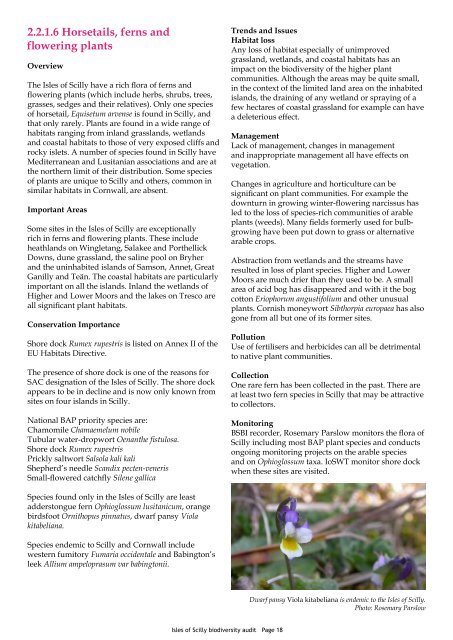The Isles of Scilly Biodiversity Audit 2008 - Cornwall Wildlife Trust
The Isles of Scilly Biodiversity Audit 2008 - Cornwall Wildlife Trust
The Isles of Scilly Biodiversity Audit 2008 - Cornwall Wildlife Trust
You also want an ePaper? Increase the reach of your titles
YUMPU automatically turns print PDFs into web optimized ePapers that Google loves.
2.2.1.6 Horsetails, ferns andflowering plantsOverview<strong>The</strong> <strong>Isles</strong> <strong>of</strong> <strong>Scilly</strong> have a rich flora <strong>of</strong> ferns andflowering plants (which include herbs, shrubs, trees,grasses, sedges and their relatives). Only one species<strong>of</strong> horsetail, Equisetum arvense is found in <strong>Scilly</strong>, andthat only rarely. Plants are found in a wide range <strong>of</strong>habitats ranging from inland grasslands, wetlandsand coastal habitats to those <strong>of</strong> very exposed cliffs androcky islets. A number <strong>of</strong> species found in <strong>Scilly</strong> haveMediterranean and Lusitanian associations and are atthe northern limit <strong>of</strong> their distribution. Some species<strong>of</strong> plants are unique to <strong>Scilly</strong> and others, common insimilar habitats in <strong>Cornwall</strong>, are absent.Important AreasSome sites in the <strong>Isles</strong> <strong>of</strong> <strong>Scilly</strong> are exceptionallyrich in ferns and flowering plants. <strong>The</strong>se includeheathlands on Wingletang, Salakee and PorthellickDowns, dune grassland, the saline pool on Bryherand the uninhabited islands <strong>of</strong> Samson, Annet, GreatGanilly and Teän. <strong>The</strong> coastal habitats are particularlyimportant on all the islands. Inland the wetlands <strong>of</strong>Higher and Lower Moors and the lakes on Tresco areall significant plant habitats.Conservation ImportanceShore dock Rumex rupestris is listed on Annex II <strong>of</strong> theEU Habitats Directive.<strong>The</strong> presence <strong>of</strong> shore dock is one <strong>of</strong> the reasons forSAC designation <strong>of</strong> the <strong>Isles</strong> <strong>of</strong> <strong>Scilly</strong>. <strong>The</strong> shore dockappears to be in decline and is now only known fromsites on four islands in <strong>Scilly</strong>.National BAP priority species are:Chamomile Chamaemelum nobileTubular water-dropwort Oenanthe fistulosa.Shore dock Rumex rupestrisPrickly saltwort Salsola kali kaliShepherd’s needle Scandix pecten-venerisSmall-flowered catchfly Silene gallicaTrends and IssuesHabitat lossAny loss <strong>of</strong> habitat especially <strong>of</strong> unimprovedgrassland, wetlands, and coastal habitats has animpact on the biodiversity <strong>of</strong> the higher plantcommunities. Although the areas may be quite small,in the context <strong>of</strong> the limited land area on the inhabitedislands, the draining <strong>of</strong> any wetland or spraying <strong>of</strong> afew hectares <strong>of</strong> coastal grassland for example can havea deleterious effect.ManagementLack <strong>of</strong> management, changes in managementand inappropriate management all have effects onvegetation.Changes in agriculture and horticulture can besignificant on plant communities. For example thedownturn in growing winter-flowering narcissus hasled to the loss <strong>of</strong> species-rich communities <strong>of</strong> arableplants (weeds). Many fields formerly used for bulbgrowinghave been put down to grass or alternativearable crops.Abstraction from wetlands and the streams haveresulted in loss <strong>of</strong> plant species. Higher and LowerMoors are much drier than they used to be. A smallarea <strong>of</strong> acid bog has disappeared and with it the bogcotton Eriophorum angustifolium and other unusualplants. Cornish moneywort Sibthorpia europaea has alsogone from all but one <strong>of</strong> its former sites.PollutionUse <strong>of</strong> fertilisers and herbicides can all be detrimentalto native plant communities.CollectionOne rare fern has been collected in the past. <strong>The</strong>re areat least two fern species in <strong>Scilly</strong> that may be attractiveto collectors.MonitoringBSBI recorder, Rosemary Parslow monitors the flora <strong>of</strong><strong>Scilly</strong> including most BAP plant species and conductsongoing monitoring projects on the arable speciesand on Ophioglossum taxa. IoSWT monitor shore dockwhen these sites are visited.Species found only in the <strong>Isles</strong> <strong>of</strong> <strong>Scilly</strong> are leastadderstongue fern Ophioglossum lusitanicum, orangebirdsfoot Ornithopus pinnatus, dwarf pansy Violakitabeliana.Species endemic to <strong>Scilly</strong> and <strong>Cornwall</strong> includewestern fumitory Fumaria occidentale and Babington’sleek Allium ampeloprasum var babingtonii.Dwarf pansy Viola kitabeliana is endemic to the <strong>Isles</strong> <strong>of</strong> <strong>Scilly</strong>.Photo: Rosemary Parslow<strong>Isles</strong> <strong>of</strong> <strong>Scilly</strong> biodiversity audit Page 18
















